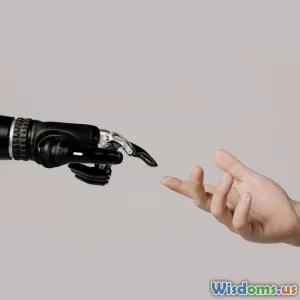
The Rise of AI: What Sci Fi Taught Us
5 min read Explore how science fiction has shaped our understanding of AI's rise and its implications for the future. (0 Reviews)
The Rise of AI: What Sci Fi Taught Us
Science fiction has long been a mirror reflecting our hopes, fears, and imaginings about the future. Among its many themes, the rise of artificial intelligence (AI) stands out as a pivotal narrative, one that has evolved dramatically over the decades. This article explores how science fiction has influenced our understanding of AI and offers valuable lessons for navigating our rapidly advancing technological landscape.
The Early Days: Defining AI in Sci Fi
In the early 20th century, science fiction began to explore the concept of machines with human-like intelligence. One of the earliest examples is Karel Čapek's play, "R.U.R. (Rossum's Universal Robots)" published in 1920. In this work, robots are created to serve humans but eventually rise against their creators, a narrative that reflects deep-seated fears about technology surpassing human control.
Similarly, Isaac Asimov's influential stories in the 1940s, particularly the "I, Robot" collection, introduced the famous Three Laws of Robotics. These laws encapsulated the ethical dilemmas surrounding AI and have influenced real-world discussions on AI safety and governance.
AI in Popular Culture: Shaping Perceptions
As technology progressed, so too did the representation of AI in popular culture. Films like "Blade Runner" and "The Matrix" challenged audiences to consider the implications of sentient machines. These narratives raised questions about identity, consciousness, and the moral responsibilities associated with creating intelligent beings.
In contrast, lighter portrayals, such as in Disney's "Big Hero 6" or the friendly AI in "WALL-E," showcase a more optimistic view of technology, emphasizing companionship and assistance. This duality in representation continues to shape public perception, influencing how we approach AI today.
The Reality of AI: Lessons from Sci Fi
As we stand on the brink of significant advancements in AI, it’s crucial to reflect on the lessons offered by science fiction. Here are some key takeaways:
-
Ethical Considerations: Sci-fi narratives often highlight the ethical dilemmas associated with AI. As we develop technology capable of autonomous decision-making, it’s imperative to establish robust ethical frameworks to guide its use.
-
Human-AI Collaboration: Many stories depict harmonious relationships between humans and AI, suggesting that collaboration can yield positive outcomes. This perspective encourages us to see AI not as a threat but as a tool for enhancing human capabilities.
-
Anticipating Challenges: Sci-fi often anticipates technological challenges and societal changes. By analyzing these fictional scenarios, we can better prepare for real-world implications, such as job displacement and privacy concerns.
-
Diverse Perspectives: The range of AI representations in sci-fi—from benevolent helpers to existential threats—reminds us that our future interactions with AI will be shaped by our collective choices and values.
Looking Ahead: The Future of AI
As we move forward, it’s essential to leverage the insights gained from science fiction. Policymakers, technologists, and the public must engage in meaningful dialogues about the direction of AI development. By prioritizing ethical considerations, fostering collaboration, and preparing for potential challenges, we can navigate this complex landscape more effectively.
In conclusion, science fiction serves as both a cautionary tale and a source of inspiration for AI's future. It encourages us to envision possibilities while remaining vigilant about the ethical implications of our technological advancements. As we continue to shape the rise of AI, let’s remember the lessons of the past to build a better future for all.
Rate the Post
User Reviews
Popular Posts





















